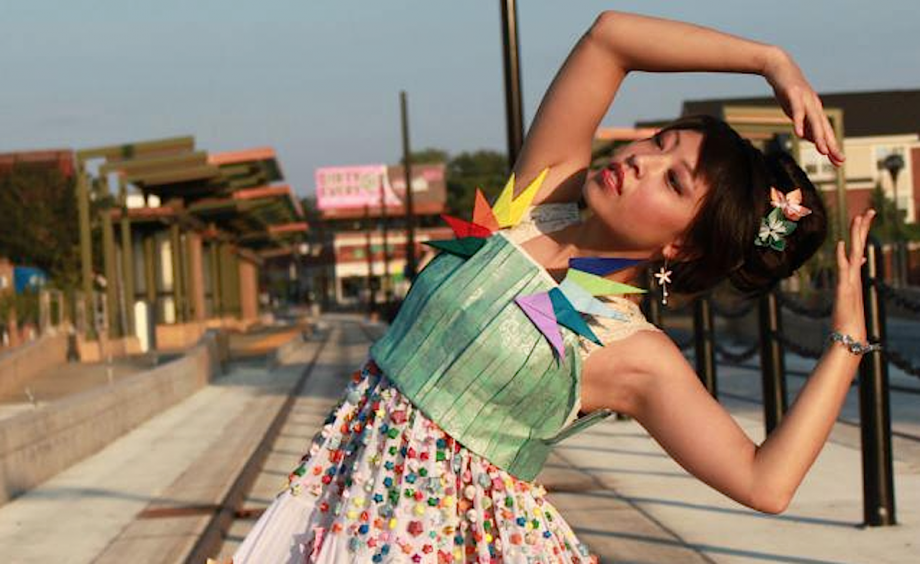
Art can cure construction headaches
St. Paul-Minneapolis artists worked with the Center for Hmong Art and Talent and transformed materials found along the construction of the new light-rail Green Line, such as origami and glass jars, into fashion for a performance.
This article is cross-posted with permission from Next City.
Imagine a big infrastructure project coming to your main street.
Imagine how a streetcar will bring new visitors to your city’s commercial strip, spending money and spreading the word about how cool your neighborhood is. Imagine how that new bus shelter will lure people out of their cars and onto public transit, or how that parklet in what was once a barren median will brighten the day of passersby.
Now imagine the months of work it takes to get that project built. The road closures. The traffic. The scaffolding blocking your favorite coffee shop’s facade.
A new initiative from a St. Paul-based arts organization can help to make sure those months aren’t miserable — and are in fact pretty enjoyable.
When St. Paul and Minneapolis were planning a new light-rail line (the Green Line, which opened this summer), Springboard for the Arts, working with the city of St. Paul and the local LISC chapter, was planning too. “The idea is, the hope, the expectation that you have when building transit is greater connectivity,” says Laura Zabel, Springboard’s executive director. “The reality of living through the construction period is really challenging.”
Springboard’s “Irrigate” project connected artists living and working in the affected area with small businesses and gave them modest grants. The artists would come up with an idea — a mural, a performance, an installation — that would remind people that these local businesses were “worth braving the construction and confusion to visit.”
For example, St. Paul’s Black Dog Cafe was almost entirely hidden by construction. “It was difficult to see that there was even a cafe there,” Zabel says. The cafe partnered with Chris Lutter-Gardella, an artist who works with puppets; he designed an enormous, two-person dog puppet that prowled the neighborhood, reminding people that Black Dog was still open.
“The day we walked the dog through Union Depot, business tripled,” owner Sara Remke told the Minneapolis Star Tribune. Not only that, but the dog started showing up at farmers’ markets and even appeared in the St. Paul St. Patrick’s Day Parade. “It’s become kind of a neighborhood mascot,” Zabel says.
Other projects beautified walls with murals or perked up bus stops with potted trees. A printmaker and designer gave away totes with literature explaining the benefits of the forthcoming light rail.
Other artists held workshops or staged performances. Mai Village, a Vietnamese restaurant, was facing foreclosure in 2012. Around the same time that the community rallied to save the restaurant, it debuted Jazz on the Line, a monthly live music night at Mai Village. “That really brought a whole new set of people to that restaurant. They’ve continued those relationships with those artists,” says Zabel. “It’s helped them find a whole new way of reaching people.”
Zabel admits that activating a community through art isn’t a new idea, but she says that what makes Irrigate different is a focus on mitigating the effects of disruption and how it built new relationships with artists and business owners.
“The goal was to create these projects, but the longer-term, more important goal was to make sure that neighborhood organizations know how to find and work with artists, and that artists know how to use their skills in service of their neighborhood.” Case in point: The puppeteer who designed the café’s giant dog was a customer. All it took was a training session and a small grant to connect them.
Springboard has released an Irrigate toolkit that other cities can use to replicate its success. Even before the toolkit was finalized, Springboard worked with a group in Cleveland during a streetscape disruption there, and Mesa, Arizona is using the toolkit to help small businesses cope during its light-rail construction.
Over the roughly three-year project, Irrigate supported 600 artists and 180 projects all along the Green Line corridor. These things “really, tangibly drew people, attention and dollars to businesses,” Zabel says. “There was a lot of concern about whether the train would be a thoroughfare to get from one city to another … because of Irrigate, because of a lot of other work that happened in the construction period, people are well aware that there are things to do along the line.”
The Irrigate project received support from Surdna and the Knight Foundation, both of which als provide funding support to Next City.
The Works is made possible with the support of the Surdna Foundation.
Recent Content
-
Artsarticle ·
-
Artsarticle ·
-
Artsarticle ·
